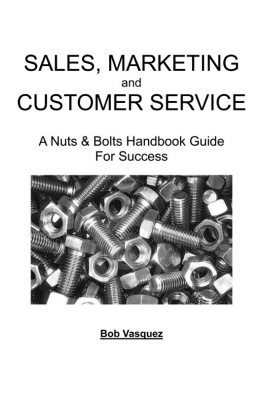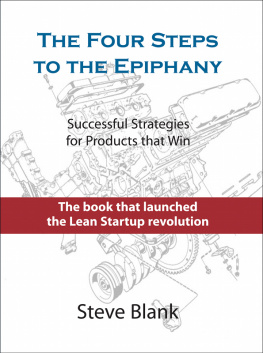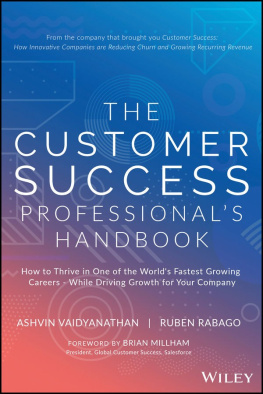Jennifer Chiang - The Startups Guide to Customer Success: How to Champion the Customer at Your Company
Here you can read online Jennifer Chiang - The Startups Guide to Customer Success: How to Champion the Customer at Your Company full text of the book (entire story) in english for free. Download pdf and epub, get meaning, cover and reviews about this ebook. year: 2019, publisher: New Degree Press, genre: Business. Description of the work, (preface) as well as reviews are available. Best literature library LitArk.com created for fans of good reading and offers a wide selection of genres:
Romance novel
Science fiction
Adventure
Detective
Science
History
Home and family
Prose
Art
Politics
Computer
Non-fiction
Religion
Business
Children
Humor
Choose a favorite category and find really read worthwhile books. Enjoy immersion in the world of imagination, feel the emotions of the characters or learn something new for yourself, make an fascinating discovery.

- Book:The Startups Guide to Customer Success: How to Champion the Customer at Your Company
- Author:
- Publisher:New Degree Press
- Genre:
- Year:2019
- Rating:5 / 5
- Favourites:Add to favourites
- Your mark:
- 100
- 1
- 2
- 3
- 4
- 5
The Startups Guide to Customer Success: How to Champion the Customer at Your Company: summary, description and annotation
We offer to read an annotation, description, summary or preface (depends on what the author of the book "The Startups Guide to Customer Success: How to Champion the Customer at Your Company" wrote himself). If you haven't found the necessary information about the book — write in the comments, we will try to find it.
Jennifer Chiang: author's other books
Who wrote The Startups Guide to Customer Success: How to Champion the Customer at Your Company? Find out the surname, the name of the author of the book and a list of all author's works by series.
The Startups Guide to Customer Success: How to Champion the Customer at Your Company — read online for free the complete book (whole text) full work
Below is the text of the book, divided by pages. System saving the place of the last page read, allows you to conveniently read the book "The Startups Guide to Customer Success: How to Champion the Customer at Your Company" online for free, without having to search again every time where you left off. Put a bookmark, and you can go to the page where you finished reading at any time.
Font size:
Interval:
Bookmark:

New Degree Press
Copyright 2019 Jennifer Chiang
All rightsreserved.
The Startups Guide to Customer Success
How to Champion the Customer at Your Company
ISBN 978-1-64137-188-9 Paperback
978-1-64137-189-6 Ebook
For the past, present, and future members of the customer success community
How to Get Buy-In
for Customer Success
We innovate by starting with the customer and working backwards. That becomes the touchstone for how we invent.
Jeff Bezos, CEO of Amazon
In the early 2000s, Amazon was struggling with a problem: how do you keep people engaged and more importantly loyal to Amazon?
Customers would only go to Amazon to buy the item that they were looking for and went along their way. There had to be a way to keep customers engaged and shopping the site.
In 2004, Amazons fourth quarter profit was $346.7 million, or 85 cents a share.
Amazon tried lowering prices of their goods to become more competitive and a promotion where there was free shipping with orders over $25 in exchange for slower delivery.
Except by now, Wall Street started to become skeptical of whether Amazon was solving the core issue. They noted that while these things helped, they questioned whether these initiatives would reduce profits too much. Theres a cost related with a lot of things they are doing, said McAdams Wright Ragen analyst Dan Geiman. Presumably they will pay off somewhere down the road.
Amazon really needed something to bring their company to the next level.
Traditionally, to solve the problem that they were having, a business would look into creating a loyalty program, such as one where customers could rack up points they could later redeem for credits or other perks.
Amazon took a different approach. Their culture is notoriously focused on customer obsession. In fact, according to Jeff Bezos, the CEO of Amazon, its their most important leadership principle.
Even when they dont yet know it, customers want something better, and your desire to delight customers will drive you to invent on their behalf, Bezos wrote in a letter to stakeholders.
In November 2004, after years of testing and searching for the right loyalty program, a software engineer by the name of Charlie Ward submitted an idea through the internal suggestion box.
Bezos was immediately enchanted by the idea, and on a Saturday evening, he gathered a group of his executives in the boathouse of his Medina, Washington home to crank out the logistics.
They worked fast; Bezos wanted this to be out and ready within two months in time for the next earnings call in January 2005.
We knew we were building something that was going to be new and different, said Amazon Vice President Greg Greeley about the planning meeting. We knew we were onto something.
With that, Amazon Prime was born pay an annual flat fee and receive unlimited two-day shipping.
It was a program that would cost them in the short term, but they knew it had potential. Prime members initially behaved differently and explored the site more (and in turn, bought more) to justify their annual fee. Over the years, Amazon added more benefits, such as unlimited video streaming or Amazon Music, to Prime membership to further promote customer loyalty and satisfaction.
The effort paid off. Looking at the data, they saw Amazon Prime members spent $1,500 a year on Amazon, which is a whopping 250% more than the non-Prime Amazon user.
In all my years here, I dont remember anything that has been as successful at getting customers to shop in new product lines, says Robbie Schwietzer, VP of Amazon Prime and an eight-year veteran of the company.
The program now boasts 100 million members in 2018 and continues to grow.
***
So what happened at Amazon?
Amazon focused on their customers success understanding what their customers pain points were and what customers needed from Amazon to become successful long-term.
In fact, there is now a whole practice around customersuccess.
Like a growth stage startup, the customer success industry is at a hockey stick moment. It has become a new fad within companies to become more customer-centric and to create customer success (CS) verticals whether established properly or otherwise and new customer success roles. Some companies have begun to reap the benefits of having a customer success team and are sharing that Kool-aid with their peers.
This industry, which started to gain momentum in 2010, now has over 3+ million profiles show up when I typed customer success into the LinkedIn search bar in 2018.
Customer success is no longer a nice-to-have, but rather an imperative for every company subscription based or otherwise to compete in todays economy. Customers are becoming more accustomed to top notch support and experience, and every company whether youre an old traditional behemoth or a new scrappy startup must adhere to those customers expectations and standards or else go down the drain.
The idea of customer-centricity isnt new. What is new is the emphasis within companies on customer-centricity. Customer success has gone from fancy customer support or account management to a company philosophy. Other teams, from marketing to production to operations, have realized the positive, multiplicative impacts of having a customer success team within their company. By working more cross-functionally, companies have adapted a more customer-centric approach to their business model. Its no longer about how do I get the customer satisfied now? But also about how do I get the customer satisfied with the product, to a point where they are super excited tell their friends about us?
***
I wanted to write this book for one reason: WhenIfirst started in customer success,Iwas lost andoverwhelmed.
As Ive learned over the past year plus writing this book, Im not alone in that feeling.
I felt lost in the dark about what customer success was, what best customer success practices would be for a company like mine (you know, non-B2B and with a very lean team), and how to even get started. Overwhelmed by the number of resources, I did not know who or what to trust. Different sources oftentimes contradicted each other and there seemed to be no true consensus.
A bit about me, I work at an education technology startup. While I was excited by the mission and the team when I was introduced to the role, I did not fully understand what I was doing or what exactly I was striving for in customer success.
The company that I work for offers 24/7, on-demand homework help via a students smartphone or tablet. Essentially, if a student is stuck on a homework problem late at night, early in the morning, or whenever really, all they had to do was open the app, take a photo of their homework problem, and they would be connected to a real live person who would help them with their problem.
At the time, my company had just started a program where we initially worked with schools to bring our product to underserved, under-resourced populations. We knew we had a product that would benefit all students, so we wanted to figure out how best to access to quality, one-on-one support to those students who may not normally have access to these kinds of resources.
Font size:
Interval:
Bookmark:
Similar books «The Startups Guide to Customer Success: How to Champion the Customer at Your Company»
Look at similar books to The Startups Guide to Customer Success: How to Champion the Customer at Your Company. We have selected literature similar in name and meaning in the hope of providing readers with more options to find new, interesting, not yet read works.
Discussion, reviews of the book The Startups Guide to Customer Success: How to Champion the Customer at Your Company and just readers' own opinions. Leave your comments, write what you think about the work, its meaning or the main characters. Specify what exactly you liked and what you didn't like, and why you think so.









